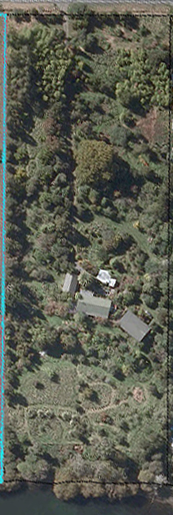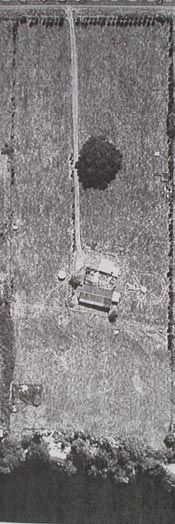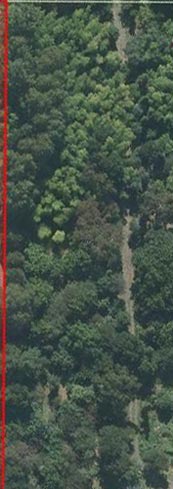
2009 Aerial view of "Tūmanako",
site of Te Māra Reo, looking east from the Waikato River.
希望

January 1996 Aerial view of "Tūmanako",
looking east from the Waikato River. This is what the site of Te Māra Reo looked like when we arrived.

Aerial view (2016) of the area reserved for the core "time travel" walk in Te Māra Reo. |
Te Māra Reo - The birth of the idea
Some time around 2005-6, some friends were asked to submit ideas for the development of green space in a new town centre being planned for one of our major cities, and asked me what I would suggest. My answer was "Why don't you develop a language garden?" I thought that this was a wonderful chance to educate New Zealanders about a dimension of their native environment that is often overlooked. My suggestion was that as many as possible of the New Zealand native plants bearing names that were brought here from Polynesia by the first settlers should be grown in a rough order of the antiquity of the name, and that where plants bearing cognate names in other parts of Polynesia could be grown (either in the open or, for example, in small conservatories scattered through the other plantings), these should be included too. All the plants should be accompanied by informative labels. That way people wandering through the garden could get a feel for the origins of our plant names, and also get to know some of the plants from other parts of the Polynesian and wider Austronesian worlds that share their names with ours.
Some of the people on the planning committee liked the idea, but the developers thought it would be difficult to organize, and might take up too much space that would better be used by buildings. "However," my friends said, "you've already got half the plants here -- why don't you just do it yourself!" I laughed at this at first, but when I looked at the records of what we had planted over the preceding decade, and checked this against a list of inherited plant names, I saw that my friends were probably right, and decided to rise to the challenge. It was a logical extension of what my late wife, Nena, my sons James and Alan, and I had been doing here since we first came to the Waikato in December 1996. When we arrived, our newly acquired 2 hectare property consisted of completely bare paddocks, surrounded by 110 pine trees around the boundary, including a dozen along the driveway, apart from a single, large oak tree about 75 metres from the gate, and a phoenix palm and a virgilia, along with a few seedling trees and shrubs, near the house. The phoenix palm, virgilia and all the pine trees, except for two which have been topped, have since been felled, replaced by 50 kauri trees and hundreds of other New Zealand native trees, along with trees to supply nectar to the birds, fruit trees to feed us (and them!) and some ornamentals. We called the place "Tūmanako" ["hope"], trusting that it would come to be a refuge which embodied the hope of a sustainable and environmentally sensitive and secure future.
So, inspired rather than disappointed by the initial rejection of our idea, we began developing and documenting a “language garden” on our riverbank land, with the ultimate aim of growing there as many as possible of the 130 or so species of native plants whose names were brought here by this country’s first Polynesian settlers. Our hope was in the long run to be able to welcome small numbers of interested visitors and school groups to see the plants and learn about the history and relationships of their names.
We had a few successful "trial runs" of a "time travel" tour, and prepared a small brochure for people doing the original 800 metre hike. One of these visits was reported in the May 2010 issue of the Waikato Botanical Society's Newsletter (click here to read it). This walk took quite a while (at least an hour, including the commentary, and often longer) and required a downhill and uphill climb, so we took the advice participants in a planning seminar we held in June 2011, and some friends experienced in guided tours in botanical gardens, of working out a new, more compact route on one level; those with plenty of energy and time on their hands could still make the longer pilgrimage should they so desire. We developed some prototype mobile-friendly pages linked to QR codes on the labels to provide information on individual plants for visitors to the garden.
Re-routing the trail sounded simple enough in principe, but has proved very difficult. Firstly, the "old" route was serendipitously able to cover in sequence the 5000 year timeline because if you circumnavigated the whole 5 acre property you could find at least one plant from each of a dozen periods in chronological sequence (albeit at irregular intervals). However you can't normally pick up a ten year old tree and put it in a new location, especially when the ideal spot is occupied by another fifteen year old tree without the right nominal whakapapa! So a compressed trail also means finding spots to plant new trees. It also means removing 20 metre high moso bamboo culms and their roots from about an acre of land, something I wanted to do anyway but which has been hindered by lack of personnel (I don't have the resources to pay anyone to do the work required, friends have been able to help only occasionally, and progress was set back further when I injured my leg and my son Alan who was giving me a hand in his spare time put his back out while doing the demolition work unaided).
Some of the stories of these plants are told in the entries relating to each of them in these web pages, and information about the plants with related names elsewhere in Polynesia and further afield is also given in these pages and in a separate set of pages for the words which the contemporary names can be traced back to. On those pages I also give accounts of the "namesake" plants, many of which I have seen myself as I have encountered and photographed them in other parts of Polynesia or Austronesia, and some of the stories attached to these. For other pages, I am very grateful to the friends and colleagues who have shared both photographs and information wih me. More material, for example guides to different stages in the history of the names, linked to the plants both in the garden and those noted in these pages (e.g. "canoe" plants that were carried from place to place by Polynesians and their Austronesian forebears as they set out to colonize new lands) are also added as the opportunity presents itself, so new options will appear ā te wā [in the fullness of time].
Although there is a lot of factual and scholarly information in these pages, there are also personal opinions, accounts and speculations which, while hopefully reasonably well-grounded, are essentially matters of opinion and might be quite wrong (not that generally accepted "facts" and scholarly findings are always right, either, of course!). This website will always be "work in progress", but hopefully the gaps will be fewer as time passes. We initially gave priority to accounts of plants that we have growing in the garden, and to those whose Maori names have Hawaiian or Samoan cognates (partly because I spent a couple of months in Hawaii in 2007, and a few more weeks in 2010, followed by brief visits to Samoa in 2014 and 2015 studying these); however, eventually all the plants listed in the "index" will have a page with some information about their Aotearoan referents, and another about the word that their current name originated from, whether they happen to be growing in our physical garden or not. That's the advantage of operating in cyberspace.
Richard Benton
Coordinator, Te Māra Reo
February 2016, Updated March 2024
|

